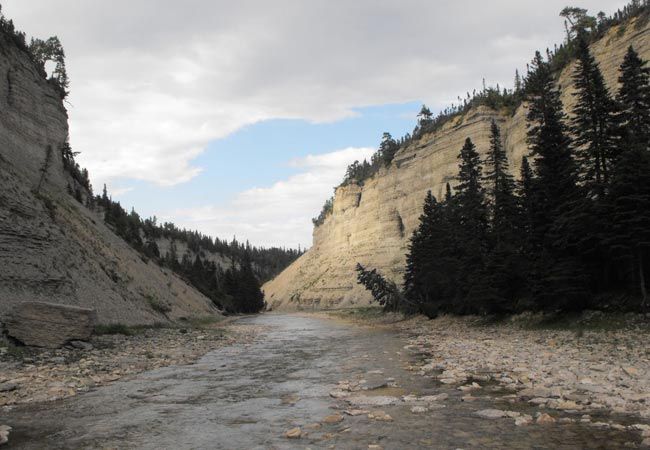Ancient Extinction Linked to Glaciers

Nearly 500 million years ago, when nearly all life was still confined to the oceans, 85 percent of marine species disappeared. New research supports a theory that implicates a double punch of climate change.
"We are interested in trying to figure out the causes of one of the major mass extinctions of the past 500 million years. People have known for a long time this is probably tied to glaciations," said study researcher Seth Finnegan, a postdoctoral researcher at the California Institute of Technology.
Using a new type of chemical analysis, Finnegan and other researchers were able to estimate the temperatures of the tropical seas where much of life was located at the time, as well as the extent of the ice sheet that rapidly expanded on the southern supercontinent Gondwana, before receding.
"At the time the mass extinction took place, we see evidence that the tropics cooled," Finnegan said. "This provides evidence there would have been direct stress on things even far from the glaciers."
And at this point, called the Late Ordovician Period, the extinction was under way.
The cold extinction
The earliest of the five mass extinctions in Earth's history, the one at the end of the Ordovician is the only one thought to involve the expansion of glaciers.
Sign up for the Live Science daily newsletter now
Get the world’s most fascinating discoveries delivered straight to your inbox.
In the Ordovician Period, before the extinction began roughly 445 million years ago, atmospheric carbon dioxide was higher than it is now, but the sun was also dimmer. A supercontinent composed of most of the landmasses now located in the Southern Hemisphere, including Africa and South America, sat on the South Pole. Nearly all life – including trilobites, corals and shelled, filter-feeding organisms called brachiopods – lived in the seas. Sea levels were much higher than they are now, and shallow seas flooded the continents.
But when glaciers in the south expanded suddenly, sea levels dropped rapidly, causing extinctions, according to Peter Sheehan, curator of geology at the Milwaukee Public Museum. The change gave an advantage to cool-water creatures, though it was relatively short lived. Estimates suggest the sharp spike in ice lasted for as little as half a million years, before melting began. Waters also warmed and sea levels returned, causing more die-offs.
"This global change is tied into these huge ice sheets," Sheehan, who was not involved in the study, told LiveScience. "This [study] is the first really good evidence of how much water was trapped in glaciers."
Finnegan and his colleagues found that the ice volumes during the sharp spike (during what is known as the Hirnantian stage) rivaled those of the most recent ice age, during the Pleistocene Epoch that ended about 12,000 years ago. During the Hirnantian the ice sheet may have contained as much as 150 million cubic kilometers (36 million cubic miles) of ice, according to Finnegan.
Just prior to this "icehouse" interval, temperatures in the tropical waters were warm, averaging about 91 to 99 degrees Fahrenheit (33 to 37 degrees Celsius). During the Hirnantian, temperatures dropped by about 5 degrees F (9 degrees C), bringing them more in line with modern temperatures near the surface of the tropical ocean, according to Finnegan.
A new technique
The findings hinge on a new technique for analyzing the geochemistry of fossils.
The researchers used fossils left by Late Ordovician creatures, including trilobites, corals and brachiopods, which had been uncovered in Kentucky, Minnesota and Anticosti Island, Quebec. Around 440 million years ago, these places were located in the tropics.
The clue to past temperatures is hidden in the molecular weight of the carbon and oxygen atoms in carbon dioxide produced by the fossils dissolved in acid. Specifically, the relative number of chemical bonds between heavier versions of carbon and oxygen, called isotopes, within this carbon dioxide is an indicator of past temperature.
"The main reason people haven't done this before is this is a hard measurement to make because both of the heavy isotopes of oxygen and carbon are relatively rare," Finnegan said. "Bonds between two rare things are really rare."
After determining the temperatures around the time the fossils were created, the researchers could look specifically at oxygen isotopes to estimate the extent of the glaciers. Molecules of water containing lighter versions of oxygen are more likely to evaporate, and under normal conditions that evaporated water reaches the atmosphere and falls as precipitation before returning to the ocean. However, when glaciers form, this precipitation does not return to the ocean — instead, the slightly lighter water becomes locked up in ice. Over time, the water in the ocean becomes heavier as a result.
"This is the first paper of its kind," Sheehan said. "We will have a lot of new information coming out over the next 10 years from this kind of study."
The World's Biggest Oceans and Seas
Mass Extinction Threat: Earth on Verge of Huge Reset Button?
You can follow LiveScience writer Wynne Parry on Twitter @Wynne_Parry.












